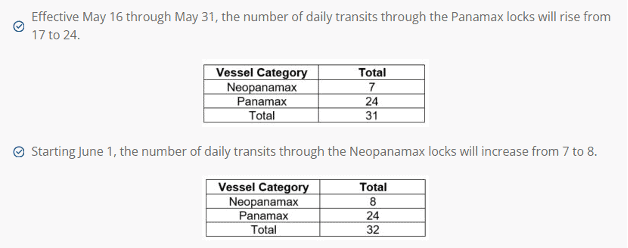During the most severe drought period in the history of the Panama Canal, we are watching the weather forecast closely. Even if rains are higher-than-expected in May, the water level in the canal is at its lowest level in recent years and there is the potential for disruptions to continue. Higher rainfall could mean some relief soon though.
The decrease in the water level of the canal can be attributed to the decrease in rainfall in Panama, and the area surrounding the canal is currently witnessing one of the two driest years on record in Panama, according to the Panama Canal Authority. It is estimated that the water levels in Gatun Lake, which feeds the canal, decreased by nearly three meters compared to normal water levels during this period.
With the Panama Canal accounting for 7% of global trade, the drought in the Panama Canal has the potential to disrupt supply chains and significantly extend shipping times.
This situation is expected to have an impact on ocean freight, as it will naturally increase costs for all parties. The Panama Canal is a critical element in the global supply chain, especially on its routes from the U.S. East Coast to Asia and from Europe to the U.S. West Coast and Canada. Last year’s severe drought forced a reduction in the number of ships allowed daily passage through the canal. In December, rains in the last quarter of the year allowed the channel to suspend additional restrictions that would have been imposed in January. However, under previous restrictions, the Canal currently allows vessels with a maximum draft of 44 feet.
The Red Sea crisis has deepened demand and capacity issues in the Panama Canal.
Attacks on ships in the Red Sea in recent months have forced many ship owners to take the longer route (around the Cape of Good Hope) to and from Asia, indirectly increasing the demand for transit through Panama. The canal currently allows an average of 24 ships to pass per day. If the rains in May are as expected and suitable conditions occur, this number is expected to rise to 32.

Despite the bottleneck and attacks in the Red Sea, the most important factor in the preference of ship owners for this waterway is the serious difference in the transportation time it creates. This is so much the case that the Panama Canal will undergo routine maintenance in the coming weeks and the rate of passage will decrease further, but this is not expected to lead to a change in the rate of ships wishing to pass through the canal.
Below is what importers and exporters should expect based on the current situation and if conditions do not occur as desired.
1. Extensions in transit times and delays in estimated arrival dates.
As a solution, although it is extremely complex and expensive, it seems to be an effective solution for American exporters to deliver cargo to U.S. West Coast ports by land or rail, to be able to load from these ports and move without the need for the Panama Canal.
2. Increases in freight rates.
Though rates are expected to rise, working with a freight forwarder will help protect your rights and have strong contracts with carrier companies to minimize your costs during such periods.
3. Potential disputes and problems with carrier companies.
Working with knowledgeable and expert freight forwarders help ensure that experienced parties can handle and track the situation for you and help avoid further problems.




